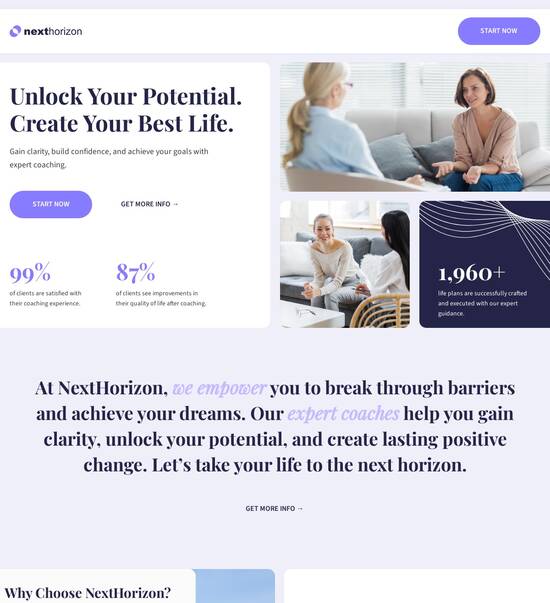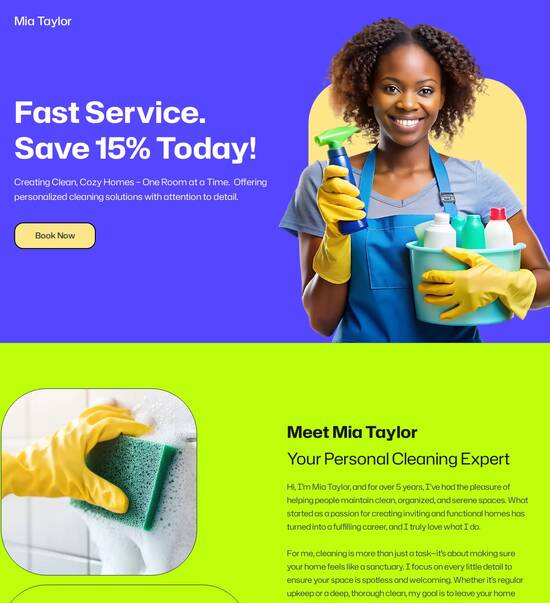
Onboarding page template for Account managers
Explore Similar TemplatesAbout template
Master your online marketing with this builder for onboarding page template for Account managers. Try more tools to create an immaculate landing page.
Recommended templates

Easy to build without coding
With the intuitive drag-and-drop builder, anyone on your team can create high-converting pages without any knowledge of code or design. Make enhancements to your landing page with custom widgets using Javascript, HTML/CSS, or third-party scripts.

Multiple layouts for any industry and goal
Select from 500+ landing page layouts built to boost conversions across industry-specific scenarios. Customize them by adjusting fonts, adding images, and generating on-brand content with the AI assistant. Quickly scale with Instablocks® and Global Blocks that you can save, reuse, and update globally.

Loads fast and looks polished on any device
Every template is responsive, which means they present professionally on any device and load blazingly fast with our Thor Render Engine. You can also power them up with Google AMP technology to deliver an unparalleled mobile experience and drive higher conversions.

Robust analytics & experimentation
Get real-time updates and reporting across all your devices, showing the number of visitors, conversions, cost-per-visitor, and cost-per-lead. Launch AI-powered experiments, run A/B tests, and use heatmaps to analyze user behavior, then optimize your landing page to maximize conversions.







Easy to build without coding
With the intuitive drag-and-drop builder, anyone on your team can create high-converting pages without any knowledge of code or design. Make enhancements to your landing page with custom widgets using Javascript, HTML/CSS, or third-party scripts.
Multiple layouts for any industry and goal
Select from 500+ landing page layouts built to boost conversions across industry-specific scenarios. Customize them by adjusting fonts, adding images, and generating on-brand content with the AI assistant. Quickly scale with Instablocks® and Global Blocks that you can save, reuse, and update globally.
Loads fast and looks polished on any device
Every template is responsive, which means they present professionally on any device and load blazingly fast with our Thor Render Engine.
Robust analytics & experimentation
Get real-time updates and reporting across all your devices, showing the number of visitors, conversions, cost-per-visitor, and cost-per-lead. Launch AI-powered experiments, run A/B tests, and use heatmaps to analyze user behavior, then optimize your landing page to maximize conversions.
All the features you need to build lead-generating landing pages
Explore more featuresLearn how to build top-performing landing pages for any goal
FAQs
Leading the way in building high-performing landing pages





An effective onboarding page template for account managers
Implementing an onboarding page template for account managers can significantly enhance the customer experience and ensure that new clients receive the support they need to get started with your service. Instapage provides powerful landing page templates specifically designed to streamline onboarding processes, optimize user engagement, and facilitate communication between account managers and clients.
Understanding the onboarding process
The onboarding process is critical for setting expectations and cultivating a positive relationship with clients. It's important to ensure that all necessary information, tools, and resources are readily available. Key considerations in developing an onboarding page include clarity, accessibility, and interactive elements that foster user engagement.
- Clear objectives: Defining the goals for the onboarding experience helps ensure that clients know what to expect.
- Interactive elements: Features such as videos or step-by-step guides can increase engagement and comprehension.
- Feedback opportunities: Encouraging clients to provide feedback during onboarding can guide improvements.
Step 1: Design your onboarding page layout
Begin by conceptualizing a user-friendly layout for your onboarding page. A well-structured layout facilitates navigation and enhances the user experience. Consider using Instapage’s diverse template options to craft a visually appealing and effective onboarding page.
Step 2: Integrate helpful resources
Next, integrate helpful resources into your onboarding page. This not only aids clients in acclimating to your service but also reinforces their relationship with their account manager. Include key information for easy access, using bullet points for clarity.
- Links to FAQs: Make sure new clients can easily find answers to common questions.
- Contact information: Clearly display how clients can reach their account manager for support.
- Training materials: Include links to webinars or tutorials that can accelerate client learning.
Step 3: Personalize the experience
Personalization is essential in building rapport with clients. Use data-driven segmentation to tailor content to specific audience needs, ensuring a targeted and relatable onboarding process.
- Dynamic messaging: Customize landing page text to appeal to different client segments.
- Segment-specific resources: Recommend additional tools or materials based on the client's specific industry.
- Progress tracking: Enable clients to track their onboarding milestones for accountability.
By integrating these elements into your onboarding page template, you'll lay a strong foundation for successful client relationships and ensure a seamless onboarding experience.
Ready to create your own onboarding page template? Leverage Instapage’s robust tools and customizable templates to foster positive interactions right from the start and set your account managers up for success.
People also ask about Onboarding page template for Account managers
Onboarding page template for account managers: A comprehensive guide
Understanding the role of the onboarding page template in account management
The onboarding page template serves as a pivotal resource for account managers, ensuring they are equipped for success right from the start. Effective onboarding is essential not just for new hires but for the overall productivity of the team. When structured well, onboarding helps newcomers acclimate to the company's culture and processes, ultimately fostering a more cohesive work environment. The first few weeks of onboarding are critical in setting the tone for future performance and engagement.
Effective onboarding influences crucial metrics like employee retention, speed to productivity, and overall job satisfaction. Companies that invest in a robust onboarding process can expect to see improved account performance and enhanced team collaboration. These efforts directly correlate with key performance indicators (KPIs) that measure both team and individual success.
Employee retention rates increase as new hires feel supported and integrated.
Improved speed to productivity through clearer expectations and training.
Higher overall job satisfaction due to a well-structured orientation.
Features of onboarding page templates tailored for account managers
A successful onboarding page template should be customizable to meet various organizational needs. This adaptability allows companies in different sectors, from tech to finance to education, to create an onboarding experience that reflects their unique branding and culture. By providing a variety of templates, businesses can select layouts that resonate with their objectives.
Integrating the company's branding into onboarding materials fosters a sense of belonging for new hires. Cohesive branding across all internal and external communications builds trust and enhances recognition. Along with visual aspects, interactive elements enhance engagement and learning. Incorporating multimedia components such as videos, infographics, and podcasts can make the onboarding process more enjoyable.
Customizable layouts that cater to different company needs.
Integration of company branding into all onboarding materials.
Interactive elements like quizzes and feedback sections.
Essential contents of an onboarding page template
Every onboarding template should include several essential components to facilitate a smooth transition for new account managers. A welcome message from leadership, for instance, can go a long way in making new hires feel valued from day one. This initial connection can set a positive tone for their entire onboarding experience.
Another critical component is an overview of department goals and the company's mission. When new hires understand the overarching objectives, they can align their efforts better within the framework of the organization's vision. Additionally, an introduction to key staff, including sales managers and relevant colleagues, facilitates early relationship-building, which is crucial for teamwork.
Welcome message from leadership or the team.
Overview of department goals and company mission.
Introduction to key staff members, including sales managers.
Detailed onboarding checklist
A detailed onboarding checklist is essential for new account managers to navigate their initial tasks systematically. This checklist should outline a step-by-step process that covers everything from mandatory training sessions to team integration activities. By breaking down tasks into manageable segments, new hires can focus on one thing at a time while gaining confidence in their new role.
Having specific timeline expectations for each checklist item is equally important. This helps set clear expectations and deadlines for new hires, allowing them to manage their time effectively. Moreover, a buddy onboarding program, where experienced account managers mentor newcomers, can enhance the learning process, providing real-world insights and support. Peer-to-peer interaction often leads to better integration and understanding of company culture.
Step-by-step tasks for new account managers.
Timeline expectations for each checklist item.
Assigning experienced account managers as buddies.
Crafting relevant action items for new hires
Aligning action items with company goals is a critical aspect of the onboarding process. New account managers should understand how their tasks directly correlate with the organization’s KPIs and performance expectations. Providing worksheets that encourage strategic thinking allows them to map their initial actions to larger objectives, ensuring a more meaningful contribution from the outset.
It's also vital to prioritize these action items effectively. Categorizing tasks into immediate and long-term goals helps streamline the onboarding process. When newcomers focus on critical first actions, they can achieve quick wins that boost their confidence and momentum. This approach not only reinforces the importance of their roles but also generates early successes that benefit the team and management.
Alignment of action items with KPIs and role expectations.
Worksheets to encourage strategic thinking.
Prioritizing tasks into immediate and long-term goals.
Pricing considerations for onboarding solutions
When considering an onboarding page template, understanding the costs associated with various solutions can be enlightening. Pricing can range significantly depending on the complexity of the templates and the features included. Average pricing for onboarding platforms often includes elements such as customized branding, interactive elements, and integrated tracking systems.
However, it's essential to weigh these costs against the potential return on investment (ROI). Companies that invest in high-quality onboarding templates can mitigate high turnover rates, resulting in substantial savings in hiring and training costs. Case studies demonstrate that organizations that enhance their onboarding processes not only improve retention but also see performance gains, further validating the need for investment in these tools.
Breakdown of average pricing across different onboarding platforms.
Investment in tools versus cost of high turnover rates.
Incremental benefits of improved onboarding experiences.
Developing a comprehensive review system
Establishing a system for gathering feedback on the onboarding process is essential for continuous improvement. Custom surveys can be a valuable tool in measuring how effective onboarding was from the perspective of new hires. By soliciting their impressions, organizations can identify strengths and weaknesses in their onboarding programs, effectively paving the way for enhancements.
Additionally, scheduling regular review sessions provides an opportunity to discuss feedback and implement necessary adjustments. Success stories and testimonials from newly onboarded account managers can also offer insight into the qualities that make the onboarding experience impactful. By emphasizing feedback, companies can create an adaptive onboarding process that strengthens their culture and fosters employee loyalty.
Custom surveys to measure onboarding effectiveness.
Scheduling review sessions for continuous improvement.
Sharing positive reviews from account managers' experiences.
Best practices for implementing an onboarding page template
Setting up a structured onboarding plan is fundamental to its success. This involves logistical considerations, such as timelines, necessary resources, and the support teams responsible for onboarding new account managers. Having a clear structure allows organizations to optimize their onboarding efforts and ensure that no crucial elements are overlooked.
Checkpoints should be integrated into the onboarding process to evaluate new account managers' progress. These checkpoints can guide managers in providing timely support where needed. Continuous evaluation and iteration of the onboarding process based on feedback will keep it relevant and effective. As companies grow and evolve, so should their onboarding strategies to follow suit.
Setting up logistics, timelines, and resources involved.
Checkpoints for evaluating progress of new account managers.
Adapting onboarding templates based on changing needs.
Building cross-departmental collaboration through effective onboarding
Effective onboarding should not be confined to a single department. The role of marketing in supporting onboarding processes is significant. By integrating marketing materials into the onboarding journey, new account managers can appreciate how their roles contribute to broader marketing goals. This collaboration not only clarifies expectations but also creates a more unified approach to achieving company objectives.
Encouraging communication across all departments is vital. New account managers should receive structured introductions to others in the organization. Building these relationships early on fosters a culture of collaboration that extends past onboarding and becomes embedded within the company's operational model. By emphasizing interdepartmental cooperation, companies can leverage diverse insights and expertise that ultimately enhance performance.
Integrating marketing materials within the onboarding journey.
Structured introductions to other departments vital for account managers.
Developing a culture of collaboration that extends beyond onboarding.
Measuring success post-onboarding
Once onboarding has concluded, it is essential to set long-term KPIs for new account managers to track their success. Measurement should encompass various aspects, including engagement levels, performance metrics, and contribution to team goals. By establishing these KPIs, organizations can assess the effectiveness of their onboarding processes and identify which areas need refinement.
Additionally, ongoing assessments of staff orientation processes should be conducted through regular check-ins. This continuous feedback loop ensures that team members feel valued and recognized, fostering a culture of learning and growth. This adaptability can lead to incremental improvements in onboarding strategies over time, providing a foundation for ongoing development.
Key indicators to track the success of onboarding initiatives.
Aligning individual performance metrics with departmental goals.
Establishing a culture of continuous learning and growth.
The future of onboarding templates for account managers
As technology advances, onboarding processes are set to become more innovative. Emerging trends and tools aim to enhance these experiences, giving organizations greater flexibility in how they onboard new hires. Automation and artificial intelligence are increasingly being utilized to create personalized onboarding journeys that cater to individual learning preferences and paces.
Looking ahead, fostering an environment where onboarding is not a one-off event but a continuous process will become increasingly critical. New account managers should view onboarding as a journey that integrates them seamlessly into company culture. Adapting to the evolving landscape of work post-pandemic will require organizations to remain agile and continuously innovate, particularly in onboarding practices.
Emerging trends and tools that enhance onboarding experiences.
Role of AI and automation in personalizing the onboarding journey.
Fostering a culture where onboarding is viewed as a continual process.
Ready to skyrocket conversions?
Supercharge your ad campaigns with high-performing landing pages
Get started














